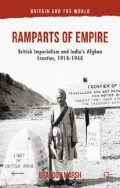Abstract
In the wake of the First World War, the British Empire stood at its greatest territorial extent. The Empire emerged from its four-year struggle with the central powers not only intact but enlarged. In Africa, the seizure of German East Africa completed Cecil Rhodes’ dream of a continent painted red from Cairo to Cape Town. In the Middle East, Lord Cromer’s “veiled protectorate” over Egypt was superseded by outright rule. Jerusalem and Baghdad, along with Nineveh and Tyre, lay at the victors’ feet. In the far-off Pacific, New Zealand’s occupation of German Samoa meant that, quite literally, the sun never set on the British Empire. Unfortunately for the British, this territorial sweep failed to translate into actual strength, and was in fact indicative of imperial overreach and weakness. As John Gallagher noted, once the Empire reached this extent, “the sun never set upon its problems.”1 In the aftermath of the First World War, Britain was financially weakened, pressed for manpower it could not spare, and confronted by an international order transformed by Bolshevism and Woodrow Wilson’s vision of “ self-determination.”2 This weakened imperial structure was further shaken by nationalist revolts in Ireland, Egypt, India, and Iraq between 1919 and 1922.
Access this chapter
Tax calculation will be finalised at checkout
Purchases are for personal use only
Preview
Unable to display preview. Download preview PDF.
Notes
John Gallagher, “Nationalisms and the Crisis of Empire, 1919–1922,” in Modern Asian Studies, 15, 3 (1981), p. 355.
See Keith Jeffery, The British Army and the Crisis of Empire, 1918–1922 (Manchester, 1984) and
Erez Manela, The Wilsonian Moment: Self-Determination and the International Origins of Colonial Nationalism (New York, 2007).
See John Gallagher, The Decline, Revival and Fall of the British Empire: The Ford Lectures and Other Essays (Cambridge, 1982).
For Ireland, see David Harkness, The Restless Dominion: The Irish Free State and the British Commonwealth of Nations, 1921–1931 (London, 1969). For Egypt, see
John Darwin, Britain, Egypt, and the Middle East: Imperial Policy in the Aftermath of War, 1918–1922 (New York, 1981).
See Peter Sluglett, Britain in Iraq: Contriving King and Country, 1914–1932 (New York, 2007).
See George Henry Bennett, British Foreign Policy during the Curzon Period, 1919–1924 (Manchester, 1995).
See John Gallagher and Anil Seal, “Britain and India Between the Wars,” in Modern Asian Studies, 15, 3 (1981), pp. 387–414, and
Judith Brown, “Imperial Façade: Some Constraints Upon and Contradictions in the British Position in India, 1919–1935,” in Transactions of the Royal Historical Society, 26, 5 (1976), pp. 35–52.
See Charles Miller, Khyber: British India’s North West Frontier, The Story of an Imperial Migraine (New York, 1977).
Evelyn B. Howell, Mizh: A Monograph of Government’s Relations with the Mahsud Tribe (Simla, 1931), p. xii. Many of Howell’s fellow Frontier officers, including Caroe, believed Howell’s monograph, Mizh, to be “the most penetrating of all tribal studies” (
Sir Olaf Caroe, The Pathans, 550BC–AD1957 (London, 1958), p. 395).
See Richard I. Bruce, CIE, The Forward Policy and its Results or Thirty-Five Years’ Work Amongst the Tribes on Our North-Western Frontier of India (London, 1900).
Abdul Ali Arghandawi, British Imperialism and Afghanistan’s Struggle for Independence, 1914–1921 (New Delhi, 1989), p. 176.
Government of India, The Third Afghan War: Official Account Compiled in the General Staff Branch, Army Headquarters, India (Calcutta, 1926), pp. 14–15.
Lieutenant-General George Noble Molesworth, Afghanistan 1919: An Account of Operations in the Third Afghan War (Bombay, 1962), pp. 120–122.
Laurence Rushbrook Williams, India in 1919 (Calcutta, 1920), p. 17.
Laurence Rushbrook Williams, India in 1920 (Calcutta, 1921), p. 8.
Mark Jacobsen (ed.), Rawlinson in India (Stroud, 2002), p. xxiii.
See John W. Cell, Hailey: A Study in British Imperialism, 1872–1969 (Cambridge, 1992).
Peter Hart’s recent The Somme (London, 2005) for example, places the bulk of the blame for the Somme debacle–particularly the infamous first morning –on Rawlinson’s shoulders rather than on his superiors, such as Field Marshal Haig.
Rawlinson Journal Entry, 18 December 1920, in Major-General Sir Frederick Maurice (ed.), Soldier, Artist, Sportsman: The Life of General Lord Rawlinson, from his Journals and Letters (Boston, 1928), p. 285.
See Sir Henry Rawlinson, England and Russia in the East: A Series of Papers on the Political and Geographical Condition of Central Asia, by Major-General Sir Henry Rawlinson (London, 1875).
On this Maffey was quite prescient. Bases in tribal territory were essentially prisons. One British soldier recalled that a plaque at the entrance to the Landi Kotal Fort in Khyber Agency read “Abandon hope all ye who enter here” (Charles Allen, Plain Tales from the Raj: Images of British India in the Twentieth Century (London, 1975), p. 203).
Confidential Memorandum from Hailey to Eric Burden (Civilian Military Secretary in the India Office), 29 October 1922, Hailey Papers E220/3c. See Leslie Gilbert Pine, The New Extinct Peerage 1884–1971: Containing Extinct, Abeyant, Dormant and Suspended Peerages With Genealogies and Arms (London, 1972), p. 141.
See William Malcolm Hailey, Baron Hailey, An African Survey: A Study of Problems Arising in Africa South of the Sahara (Oxford, 1938).
Author information
Authors and Affiliations
Copyright information
© 2015 Brandon Marsh
About this chapter
Cite this chapter
Marsh, B. (2015). “A Continual and Gratuitous Provocation”: The North-West Frontier and the Crisis of Empire, 1919–1923. In: Ramparts of Empire. Britain and the World. Palgrave Macmillan, London. https://doi.org/10.1057/9781137374011_3
Download citation
DOI: https://doi.org/10.1057/9781137374011_3
Publisher Name: Palgrave Macmillan, London
Print ISBN: 978-1-349-47678-7
Online ISBN: 978-1-137-37401-1
eBook Packages: Palgrave History CollectionHistory (R0)

